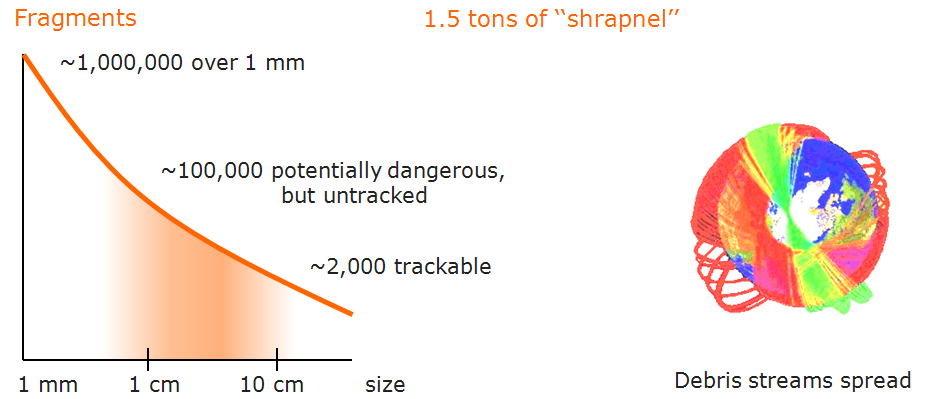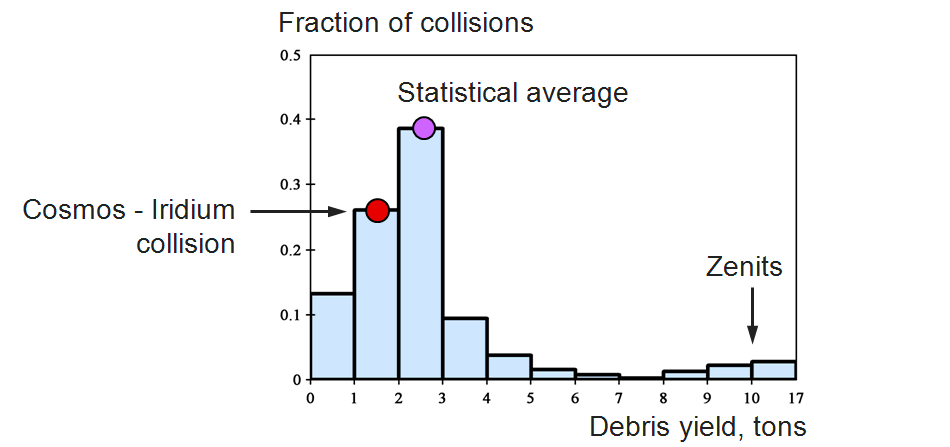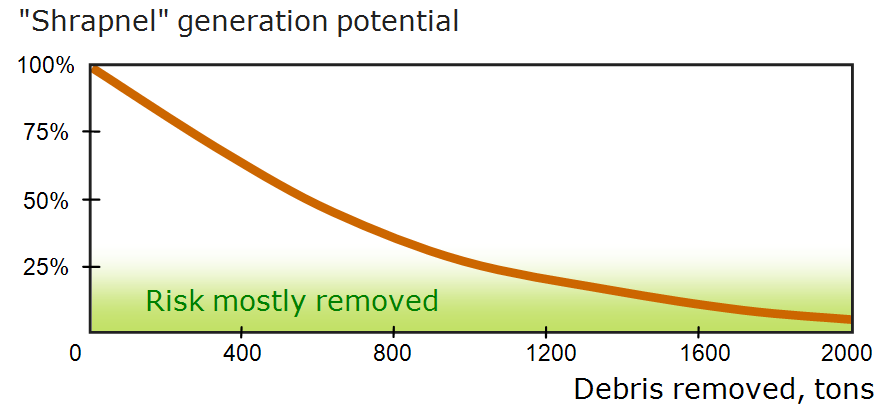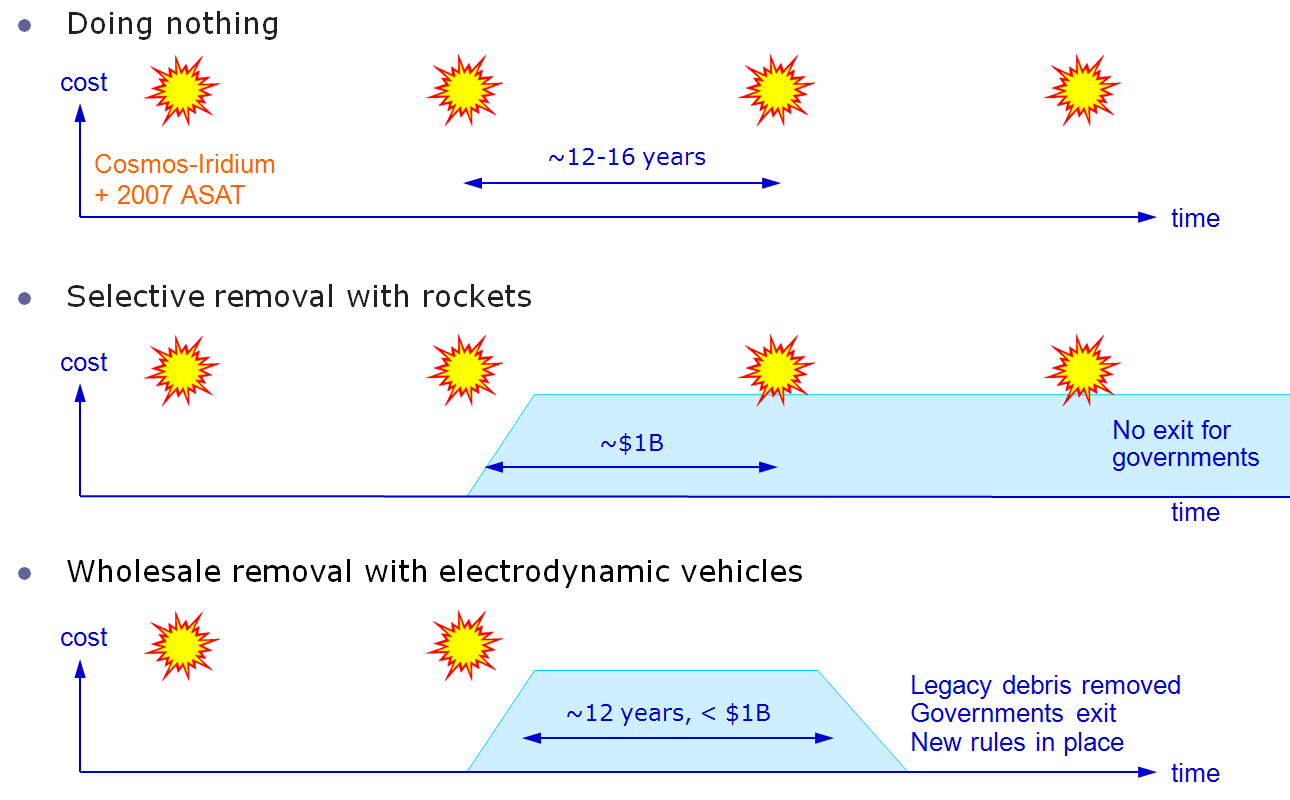Wholesale Debris Removal
As debris mitigation practices improve, catastrophic collisions involving large debris objects can become the dominant source of debris pollution in low Earth orbits. These collisions will produce hundreds of thousands of debris fragments in the centimeter range (shrapnel
) that are hard to track, but could be lethal to operational spacecraft. Collision fragments form streams centered around the orbits of the originating objects, and with time, their nodes spread due to the differential nodal regression, forming shells around the Earth and creating substantial risk to the operational spacecraft. The chart below illustrates the fallout from the Cosmos-Iridium collision.

- The Fallout from the Cosmos-Iridium Collision
Statistical estimates suggest that the next catastrophic collision between intact objects is likely to yield as many fragments as the Iridium-Cosmos collision and Chinese ASAT test combined, and that collisions of such magnitude may occur every 12-16 years on average.

- Statistical Distribution of the Yield of Collision Fragments
Analysis shows (view PDF) that the primary loss occurs not in the catastrophic collision itself, but within a decade after the collision, when pieces of untracked shrapnel
produced in that collision hit valuable assets. It could be hidden
losses, because it may be hard to determine the true reason for the asset failures. A substantial fraction of this damage will come from impacts on high-value assets, not only because they are expensive, but also because they have large target areas.
To radically reduce the frequency of catastrophic collisions and the generation of debris fragments in the future, debris removal will have to be carried out on a wholesale basis, as seen from the chart below.

- Wholesale Removal of Large Debris Will Make a Big Difference
Analysis of the shrapnel
generation potential of various sub-populations of large debris suggests that the cleanup efforts should focus on the 71–74°, 81–83°, and sun-sync clusters. Removing all rocket bodies from these clusters could reduce the future growth of the population and fluxes of small but potentially lethal debris fragments by a factor of four.

- Mass of the Rocket Bodies in the Inclination Clusters
Wholesale debris removal is a very challenging task. With 2200 dead satellites and rocket bodies scattered all over LEO (2000 tons total), it would take 2200 trips with an average payload of 900 kg to remove all rocket bodies and dead satellites from LEO. Rockets are not suited for this task, because the existing propulsion systems have specific impulses much lower than needed for affordable wholesale debris removal from LEO (view PDF). Being propellantless and lightweight, electrodynamic vehicles can reduce the cost of debris removal per unit mass to a small fraction of the typical launch costs and enable wholesale removal (view PDF).
With today's technology, there are three options for dealing with the debris situation. The first option is to wait for technological advances, accepting that the space environment may deteriorate further. The second option is to selectively remove large legacy debris with rockets. This may require spending on the order of $1 billion every 12-16 years to stabilize the population of LEO debris at the current levels and may not allow governments to exit, as catastrophic collisions will continue and the expense will be recurring.

- Three Possible Scenarios for Debris Removal in Low Earth Orbit
The third option involves wholesale removal of debris with electrodynamic vehicles or other propellantless technologies, as they are developed. It may require governments to spend under $1 billion over a decade or so to remove all intact legacy debris (view PDF), but could allow governments to establish new rules of debris disposal and exit after the wholesale removal of the legacy debris is accomplished (view PDF).
ElectroDynamic Debris Eliminator (EDDE) is a variant of a spacecraft with electrodynamic propulsion optimized for debris removal from LEO. The animation below shows how 12 EDDE vehicles, 100 kg each, launched as secondary payloads on one ESPA ring could theoretically remove all large intact debris from LEO in 7 years. The debris objects are dragged to altitudes below the ISS, where they are left for natural decay. In the animation, the debris objects are red and the EDDE vehicles are green when free-flying, but turn yellow when dragging down a debris object. The descent is slower with heavy objects and faster with lighter objects.
- Debris Removal simulation
Space debris is becoming such a prevalent reality that it served as the set and plot device of the 2013 movie, Gravity
, where an astronaut is stranded in a shuttle crippled by a tidal wave of debris triggered by a catastrophic collision. In the bonus materials for the movie, EDDE (stylized per director’s vision) is depicted as a means to clean up near-Earth debris.


- Poster for the movie, Gravity, and 3D EDDE rendering (Source: Movie Insider, Star Inc.)
 Electrodynamic Technologies
Electrodynamic Technologies